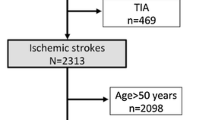Abstract
Analysis of stroke subtypes is important for making treatment decisions and prognostic evaluations. The TOAST classification system is most commonly used, but the CCS and ASCO classification systems might be more useful to identify stroke etiologies in young patients whose strokes have a wide range of different causes. In this manuscript, we aim to compare the differences in subtype classification between TOAST, CCS, and ASCO in young stroke patients. The TOAST, CCS, and ASCO classification schemes were applied to 151 patients with ischemic stroke aged 18–49 years old and the proportion of subtypes classified by each scheme was compared. For comparison, determined etiologies were defined as cases with evident and probable subtypes when using the CCS scheme and cases with grade 1 and 2 subtypes but no other grade 1 subtype when using the ASCO scheme. The McNemar test with Bonferroni correction was used to assess significance. By TOAST, 41.1% of patients’ stroke etiology was classified as undetermined etiology, 19.2% as cardioembolic, 13.2% as large artery atherosclerosis, 11.3% as small vessel occlusion, and 15.2% as other causes. Compared with TOAST, both CCS and ASCO assigned fewer patients to the undetermined etiology group (30.5% p < 0.001 and 26.5% p < 0.001, respectively) and assigned more patients to the small vessel occlusion category (19.9%, p < 0.001, and 21.9%, p < 0.001, respectively). Additionally, both schemes assigned more patients to the large artery atherosclerosis group (15.9 and 16.6%, respectively). The proportion of patients assigned to either the cardioembolic or the other causes etiology did not differ significantly between the three schemes. Application of the CCS and ASCO classification schemes in young stroke patients seems feasible, and using both schemes may result in fewer patients being classified as undetermined etiology. New studies with more patients and a prospective design are needed to explore this topic further.
Similar content being viewed by others
References
Adams HP Jr et al (1993) Classification of subtype of acute ischemic stroke. Definitions for use in a multicenter clinical trial. TOAST. Trial of Org 10172 in acute stroke treatment. Stroke 24(1):35–41
Lee LJ et al (2000) Impact on stroke subtype diagnosis of early diffusion-weighted magnetic resonance imaging and magnetic resonance angiography. Stroke 31(5):1081–1089
Ferro JM, Massaro AR, Mas JL (2010) Aetiological diagnosis of ischaemic stroke in young adults. Lancet Neurol 9(11):1085–1096
Wolf ME et al (2015) Phenotypic ASCO Characterisation of Young Patients with Ischemic Stroke in the Prospective Multicentre Observational sifap1 Study. Cerebrovasc Dis 40(3–4):129–135
Spengos K, Vemmos K (2010) Risk factors, etiology, and outcome of first-ever ischemic stroke in young adults aged 15 to 45—the Athens young stroke registry. Eur J Neurol 17(11):1358–1364
Ay H et al (2007) A computerized algorithm for etiologic classification of ischemic stroke: the causative classification of stroke system. Stroke 38(11):2979–2984
Amarenco P et al (2009) New approach to stroke subtyping: the A-S-C-O (phenotypic) classification of stroke. Cerebrovasc Dis 27(5):502–508
Putaala J et al (2009) Analysis of 1008 consecutive patients aged 15 to 49 with first-ever ischemic stroke: the Helsinki young stroke registry. Stroke 40(4):1195–1203
Varona JF et al (2007) Causes of ischemic stroke in young adults, and evolution of the etiological diagnosis over the long term. Eur Neurol 57(4):212–218
Cerrato P et al (2004) Stroke in young patients: etiopathogenesis and risk factors in different age classes. Cerebrovasc Dis 18(2):154–159
Musolino R et al (2003) Ischaemic stroke in young people: a prospective and long-term follow-up study. Cerebrovasc Dis 15(1–2):121–128
Chen PH et al (2012) Classifying Ischemic Stroke, from TOAST to CISS. CNS Neurosci Ther 18(6):452–456
Amarenco P et al (2009) Classification of stroke subtypes. Cerebrovasc Dis 27(5):493–501
Wolf ME et al (2012) Comparison of the new ASCO classification with the TOAST classification in a population with acute ischemic stroke. J Neurol 259(7):1284–1289
Arsava EM et al (2010) The causative classification of stroke system: an international reliability and optimization study. Neurology 75(14):1277–1284
Marnane M et al (2010) Stroke subtype classification to mechanism-specific and undetermined categories by TOAST, A-S-C-O, and causative classification system: direct comparison in the North Dublin population stroke study. Stroke 41(8):1579–1586
Desai JA et al (2014) Etiologic classification of TIA and minor stroke by A-S-C-O and causative classification system as compared to TOAST reduces the proportion of patients categorized as cause undetermined. Cerebrovasc Dis 38(2):121–126
Chatzikonstantinou A, Wolf ME, Hennerici MG (2012) Ischemic stroke in young adults: classification and risk factors. J Neurol 259(4):653–659
Suwanwela NC, Poungvarin N, Asian P (2016) Stroke advisory, stroke burden and stroke care system in Asia. Neurol India 64(Suppl):S46–S51
Wu CY et al (2010) Stroke risk factors and subtypes in different age groups: a hospital-based study. Neurol India 58(6):863–868
Yesilot Barlas N et al (2013) Etiology of first-ever ischaemic stroke in European young adults: the 15 cities young stroke study. Eur J Neurol 20(11):1431–1439
Prasad K, Singhal KK (2010) Stroke in young: an Indian perspective. Neurol India 58(3):343–350
Balci K et al (2011) Ischemic stroke in young adults: risk factors, subtypes, and prognosis. Neurologist 17(1):16–20
Author information
Authors and Affiliations
Corresponding author
Ethics declarations
Funding
There was no funding for this study.
Conflict of interest
Author Elif Gökçal declares that she has no conflict of interest. Author Elvin Niftaliyev declares that he has no conflict of interest. Author Talip Asil declares that he has no conflict of interest.
Human and animal participants rights
All procedures performed in studies involving human participants were in accordance with the ethical standards of the institutional and/or national research committee and with the 1964 Helsinki declaration and its later amendments or comparable ethical standards. The data was obtained from our hospital records retrospectively for the study.
Informed consent
No informed consent was neccessary for the study.
Rights and permissions
About this article
Cite this article
Gökçal, E., Niftaliyev, E. & Asil, T. Etiological classification of ischemic stroke in young patients: a comparative study of TOAST, CCS, and ASCO. Acta Neurol Belg 117, 643–648 (2017). https://doi.org/10.1007/s13760-017-0813-8
Received:
Accepted:
Published:
Issue Date:
DOI: https://doi.org/10.1007/s13760-017-0813-8




